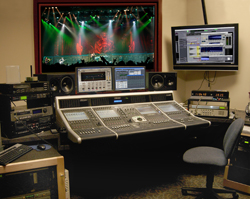
The other configuration was for quick turnaround for live-to-disk recordings where we brought in a dedicated Pro Tools engineer to insure the quality of the recording in real-time. This setup incorporated a 500-foot, 32-channel LightViper fiber optic snake system into the recording setup.
The output of the microphone after the splitter hit the analog mic preamp, then out of the analog pre amp into a pair of Apogee AD-16Xs, where the signal was converted to AES/EBU digital. The LightViper took the digital AES/EBU in and put out that same signal on the other end, where we hit the AES/EBU inputs to Pro Tools.
The mic preamps could be located on stage or at front of house, and the computer could be located up to 500 feet away. This versatility allowed the Pro Tools engineer to eastablish a remotely located mini recording studio away from the loud gig volume.
The mic pre rack and the recording rack were each only 15 spaces in height and fit in shock-mounted shells. We also carried two Pelican cases, with one holding the 22-inch display, and a Command 8 and a CD burner, while the other held a pair of M-Audio BX8A powered monitors.
The archived shows were recorded in 24-bit resolution at 48 KHz, which used about 30 GB of hard drive space for each hour-and-a-half long show. At the start of the tour, we were using specialty hard drives manufactured specifically for pro audio for the archive and working drives.
While the 120 GB “working” drives that got shipped out when a show needed to be mixed elsewhere worked well, the 500 GB drive that we were using for archiving had issues. It turned out that the low frequencies from the subs were causing the hard drive to skip, resulting in drive record errors and shutting the drive down. The problem was solved by switching to Seagate 750 GB drives that operated without any issues while being subjected to the most extreme volumes.
Storing and keeping track of the multi-tracks while maintaining a safe redundancy was a challenge. After trying several different systems, we settled on using the Seagate 750 GB drives as archive master drives, recorded each show on the 750, and then the following day, the show was backed up to a 1 terrabyte Maxtor drive.
When a Seagate reached capacity, it was then shipped back to one of the Peppers’ recording engineers to be mirrored. The master and mirror drives were then put in storage, and when it was confirmed that the mirror has occurred, we then wiped the terrabyte drive and started using it and a new 750 gig for a fresh set of shows.
Admittedly, recording is far from my favorite thing. However when a live recording is released with my name on it, it really does make me happy. It is a love/hate thing.
I’m a fish out of water in the recording world but with a compact, easy -to-use and reliable setup, even a knucklehead live guy like me can derive a bit of enjoyment and more importantly, it helps the prevent the memory of what I have spent a good portion of my life doing from fading silently into the past.
Dave Rat is the co-founder and owner of Rat Sound, a leading sound reinforcement company based in California.
